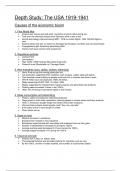Depth Study: The USA 1919-1941
Causes of the economic boom
1. First World War
• America lent money and sold arms, munitions & food to allies during war.
• Took over the chemical industry from Germany while it was at war.
• Aircraft technology improved during WW1: 1918 no civilian flights, 1930 162,000 flights a
year.
• America joined war late, so wasn’t as damaged as European countries and recovered faster.
• Propaganda taught Americans advertising skills.
• Factory work gave women work experience.
2. Republican policies
• Laissez-Faire
• Low taxation
• High Tariffs (1922 Fordney McCumber food tariff).
• Powerful trusts (Rockefeller oil, Carnegie Steel)
3. New Industries (cars, radios, clothes, electricity)
• Henry Ford set up first moving production line.
• Car production supported other industries such as glass, rubber steel and leather.
• Cars boosted house building as people could now live in suburbs and drive to work.
• 1919 9 million cars manufactured, 1929, 26 million.
• Radio ownership 60,000 1920, 10 million 1929.
• Radios supported the entertainment industry (sports) and advertised new products.
• Clothing sales increased 4 times in the 1920’s.
• 1929, 70% Americans had electric lights in their homes.
4. Mass consumption and advertising
• Posters, radios and salesmen advertised products.
• Huge growth in mail-order companies, meaning people in remote areas could buy products.
• 1930, ⅓ Americans bought things from Sears (mail-order company).
• Hire-purchase scheme meant people could “buy now, pay later”.
• 8/10 radios and 6/10 cars bought on credit.
• Chain stores set up.
5. State of mind
• Massive increase in confidence.
• Businessmen invested in new industries.
• Businesses experimented with new ideas and employed more as they grew.
• Number of shareholders increased 5x during the 1920’s.
• Average working week decreased 3.2 hours during the 1920’s.
• Average wages increased 11% during the 1920’s.
6. Industrial strength
• America rich in coal, oil, timber, steel.
• This powered factories and provided material for industries such as cars.
• By the 1930’s, number of roads doubled, and number of trucks/lorries tripled.
, Problems in the farming industry
• Declining exports to Europe (as it was poor after the war and didn’t want to trade with the
USA due to its high tariffs)
• New competitors (Canadian wheat producers were efficient and the USA had a declining
population, therefore fewer mouths to feed).
• Overproduction (improved machinery/fertilisers grew incredibly efficient).
• Falling prices (1921, farm prices fell 50%)
Problems in the traditional industries
• Overproduction of coal meant prices dropped, and increased efficiency meant less was
needed.
• Leather and textile workers lost jobs as processes became more mechanised.
Unemployment
• The boom didn’t create too many new jobs as it was largely made by electrifying and
mechanising processes.
• Unskilled workers in Chicago became seasonally unemployed during slack periods.
Entertainment Industry
• Radios advertised products, made sport more popular and supported higher-purchase
schemes.
• Jazz music and flappers pushed the social boundaries.
• The popularity of sports like baseball and boxing increased the demand for radios.
• People spent disposable income on cinema tickets (100 million a week by the end of the
1920’s).
Flapper
• Young female, short skirts, make-up, smoked in public, part of the rebellious urban
population, often found in jazz halls.
Morals
• Actresses such as Theda Bara were presented as sex symbols in the film industry.
• Hollywood films such as “Forbidden Path” were very daring for the time.
• Hays Code 1930 regulated the moral content of films.
Women
1. Women (positive)
• Gained factory experience from WWI.
• Got the vote in 1920.
• New products theoretically made housework easier.
• Began being more daring in urban areas (drinking, smoking, kissing).
• Women employment rose 24% during the 1920’s.
• 100,000 more divorces in 1929 than 1914.
• Influenced by the increasingly daring films.
2. Women (negative)
• One of the reasons women's employment grew was because they were paid less.
• Female political candidates were considered “unelectable”.
• Traditional religion and old country values were still kept by a lot of women.
3. Eleanor Roosevelt
• High standing female public figure.
• Heavily involved in League of Women Voters and Women's Trade Union League.





